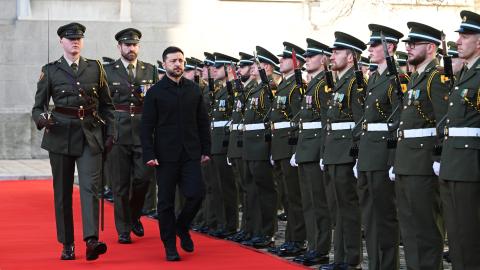Executive Summary
- Battlefield assessment: The Russian military crossed the Vovcha River in eastern Ukraine and planted a flag in the city of Dachne. Russian forces also made important tactical gains in Myrnohrad.
- Ukraine’s deep-strike campaign: Ukraine continued to target Russia with long-range strikes, hitting an oil refinery and a military compound hundreds of miles from the border.
- Drone warfare update: Ukraine equipped its Baba Yaga night bomber drones with artillery munitions, which have the potential to inflict significant damage on Russian personnel and hardware.
1. Battlefield Assessment
Last week the Russian military gained momentum with its offensive river-crossing operations on the Vovcha River in eastern Ukraine. Russian forces crossed the river and planted flags in Dachne in Dnipropetrovsk Oblast. This breakthrough could enable a domino effect that could catalyze further Russian gains.
Control of Dnipropetrovsk Oblast has significant strategic value. Seizing the region has long been an operational goal of the Russian high command. The Dnipropetrovsk region is home to hundreds of thousands of Ukrainians and significant mineral resources, along with the heavy industry to process them. Should Russia broaden its push, the Ukrainian military would face another troublesome front that could require additional combat formations and warfighting capabilities to stabilize.
Russia continued to make tactical gains on several other fronts, including Myrnohrad, Pokrovsk, Toretsk, and Velyka Novosilka. This report will continue to monitor these developments, particularly the Myrnohrad axis.
2. Ukraine Ramps Up Long-Range Salvos
On July 1 the Ukrainian Security Service (SBU) launched drones at a critical Russian military compound in the city of Izhevsk, more than 800 miles from the Ukrainian border. The SBU’s robotic warfare platforms, equipped with combat-evolved targeting systems, hit the Kupol plant in the Udmurt Republic of Russia. As a part of Russia’s defense-industrial complex, the facility is subject to international sanctions. It manufactures attack drones, as well as Tor and Osa air defense systems, for the Russian military.
That same day, Ukrainian drones damaged the Saratovorgsintez oil refinery and chemical plant in Russia’s Saratov Oblast. The facilities, operated by the Russian energy giant Lukoil, are in the city of Saratov, approximately 930 miles from the Ukrainian border. The city hosts numerous other important military and industrial locations.
Ukrainian Defense Intelligence (GUR) drone warfare teams also hit high-value targets, including Russian S-400 surface-to-air missile (SAM) systems, in the occupied Crimean Peninsula. Ukraine’s long-range strike capabilities have proven crucial to the nation’s strategic deterrence against a militarily stronger Russia. Ukraine’s indigenous drone program plays an integral part in sustaining its salvos against Russian targets hundreds of miles from the border.
3. Ukraine Equips Night Bomber Drones with Principal Artillery Rounds
While small quadcopters and first-person-view systems garner headlines, Ukraine’s night bomber drones have inflicted significant casualties on Russian forces. The drones, which Russian soldiers have dubbed Baba Yaga after a fearsome character from Slavic folklore, were designed for agricultural uses and were initially deployed to monitor and spray fields.
The war has given them a different purpose. Now equipped with thermal imagers, ballistic calculus systems, and aerial munitions, these drones showcase the adaptability and innovativeness of the Ukrainian Armed Forces.
Recent open-source intelligence suggests that Ukraine’s Baba Yaga variants can now hit Russian targets with 122mm- and 155mm-class artillery rounds. While this configuration’s combat effectiveness will become clearer in the coming weeks, it holds the potential to inflict severe damage on Russian positions.


















